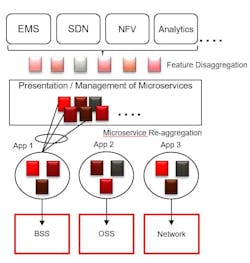Telcos Tackle Big Challenges in Small Packages
As communication service providers (CSPs) jockey for position in today’s competitive landscape, greater service agility and efficiency are paramount -- particularly as they roll out 5G networks. But this network transformation goes beyond just upgrading hardware to next-generation architectures.
With the transition to virtualized networks and software-defined networking (SDN), CSPs are designing and deploying networks that more easily adapt in real-time to the rapidly changing needs of their businesses. However, to enable the dynamic flexibility required in today’s more complex networks, the conventional approach to software development needs to evolve as well.
Traditionally, telecom applications have been developed in monolithic frameworks, such as element management systems (EMS) or network assurance platforms. These software stacks are time-consuming to modify, require lengthy deployment times, and lack the ability to scale across cloud environments. In the current dynamic networking environment, legacy software platforms simply cannot keep pace with demand for new and upgraded customer experiences, network features, and capabilities.
Consequently, more service providers are now taking a page from the DevOps playbook and turning to microservices — a faster, more flexible approach to precision application development in small software packages.
Inside the Box
Microservices leverage a simplified architecture for a more agile approach to software development. A microservices architecture allows the creation of containerized, modular pieces of code in rapid development and release cycles, following the continuous integration/continuous delivery (CI/CD) methodology. These standalone software modules are designed to be developed, deployed, tested, and scaled individually to focus precisely on a specific problem or area of improvement, thereby addressing targeted service provider challenges more quickly.
A microapplication consists of individual microservices pre-packaged with workflow automation, application programming interface (API) integration, and a user-friendly interface, tailored to any service provider’s ecosystem. When coupled with open-source frameworks, which enable greater collaboration and interoperability, these automated applications can be portable within any network environment.
By making use of a consistent delivery mechanism and lighter, more scalable, container-based development, microservices can quickly scale to meet rapidly changing customer demands and network conditions. Plus, the automation of testing procedures, process flows, and repetitive tasks eliminates lengthy development times while helping to reduce operational costs.
Think Small
The evolution to disaggregated hardware architecture has infused today’s networks with greater agility and scalability. By disaggregating software components that were previously embedded in monolithic platforms, modular applications can match the flexibility of the hardware to enable faster time to market for new features, services, capabilities, and upgrades.
With the progression to precision microservices, customized software can be quickly developed, released, and scaled, while using fewer resources, by addressing big challenges in small increments. In this way, service providers can focus on a single application designed to address a specific task or automated workflow, delivering results faster and more economically than traditional software development to save time and money.
This agile approach can be applied to a wide variety of networking and operational tasks, ranging from system provisioning to service assurance. In fact, nearly any workflow executed via a scripting language can be automated with microservices.
Operations tasks might include automated backup or reconfiguration of network elements, circuit inventory requests, service deployment to meet customer service level agreement (SLA) requirements, or automated bill-of-material creation. Likewise, networking functions can be addressed with microservices, from wavelength validation and path computation, to routing protocols. CSPs can address network modernization goals with machine learning applications or accelerate lab testing and certification cycles with precision testing apps.
Big Rewards
Although microservices come in small packages, they can be used to address big challenges. For example, a North American service provider needed to upgrade its legacy system for backing up a database of transport network elements. Despite serving several million residential and business subscribers with high-speed internet, phone, and TV service, the CSP had been relying on a homegrown backup system for years — even after the engineer who had developed the system was no longer available to support it.
The in-house backup system was not intuitive, and with the developing engineer gone from the company, adding new network elements (NEs) became a difficult ordeal. Eventually, the CSP found that more and more NEs lacked adequate backup protection and tens of thousands of NEs were not being backed up at all. This left the network exposed to potential outages.
Without adequate database backup, it was taking an average of 16 hours to restore a single NE from scratch, with weeks of repercussions afterwards. In the event of a catastrophic network event, service delivery and customers would be significantly affected, risking serious damage to the service provider’s business. Faced with this vulnerability, the service provider needed to engineer a new backup system.
In an effort to create a simple, scalable solution with automated data backup functionality, the CSP opted to use microservices. The result was a full-featured NE backup application that could be quickly deployed to protect the network infrastructure. Built on an open-source framework, the NE backup application can manage multivendor components throughout the transport network, eliminating manual interactions with backup databases. Scheduling, user management, and activity reporting are all handled through a web-based interface.
First or Fail
In today’s aggressive market, service providers who are slow to modernize can risk losing competitive advantage, customers, and profits. As CSPs look to transform their networks to increase service agility and generate new revenue opportunities, migration from monolithic software stacks to precision microservices is one way to achieve the speed and efficiency they need to be first out of the starting gate. Because in the race to 5G, failure to lead with new and improved customer experiences can mean the difference between winning or being left in the dust.
Joe Krystofik is network automation product manager at Fujitsu Network Communications.
About the Author
Joe Krystofik
Network Automation Product Manager
Joe Krystofik is network automation product manager at Fujitsu Network Communications.

